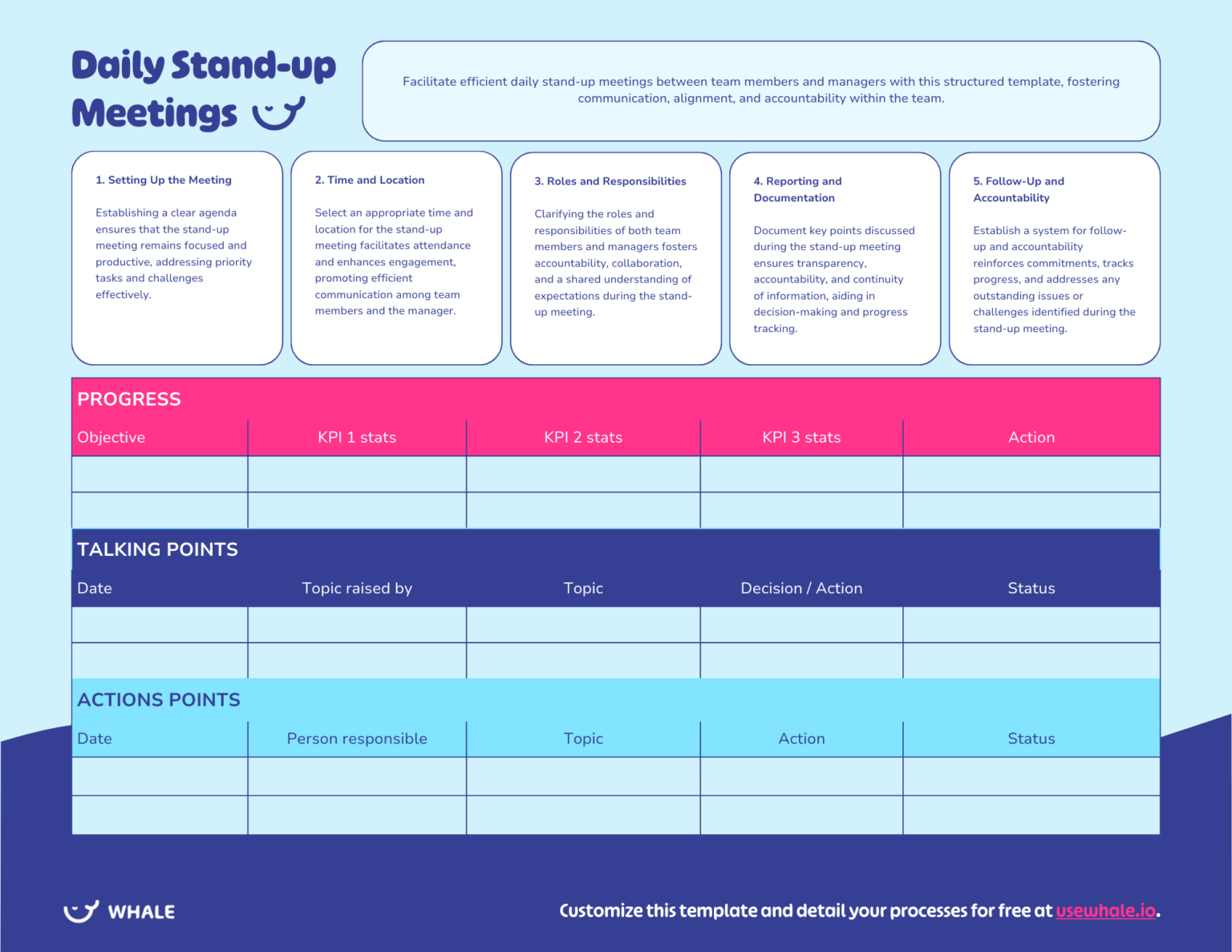Daily standup meetings have become increasingly popular among businesses of all sizes, particularly among fast-moving startups and growth-oriented companies.
In this guide, we’ll explore what daily standup meetings are, their benefits, and how to conduct them effectively to unlock your team’s potential and propel your business forward.
We’ll also make sure to answer any questions you might have.
Let’s go!
What is a daily standup meeting?
A daily standup meeting, also known as a daily scrum, is a brief, time-boxed meeting, typically lasting no longer than 15 minutes, designed to allow team members to synchronize their work and plan for the day ahead.
During these meetings, each team member quickly discusses what they accomplished yesterday, what they aim to achieve today, and any obstacles they might be facing.
Why do you need a daily standup meeting?
The primary goal of having a daily standup meeting is to ensure progress on a particular project in order to meet deadlines.
The meeting is NOT ❌ designed;
- To talk about your weekend
- For personal issues
- As a long, in-depth discussion (This is not a 90-minute L10 meeting)
It’s a project discussion in action; it’s fast but not furious.
Maria C on Agile State of Mind
Use our templates to fast-track your documentation
Customize this template and 100s of others for free in Whale, the fastest way to get your team aligned.
What are the benefits of a daily standup meeting?
Daily standup meetings are all about enhancing team productivity and project momentum. It’s all about supercharging your meeting time.
They create;
- Enhanced Communication: Regular standups foster open communication, ensuring everyone is aware of the team’s progress and challenges.
- Increased Efficiency: By limiting the time spent on meetings, teams can focus more on execution.
- Problem-Solving: Quick updates allow teams to identify and address roadblocks promptly.
- Team Alignment: Ensures that every team member is working towards the same goals and understands their role in the bigger picture.
For example, a study by Atlassian found that teams that conduct daily standups are 22% more likely to finish projects on time, highlighting the efficiency of this practice.
5 Best practices for daily standup meetings
To make the most of your daily standups, consider these best practices:
Morning vibes
Hold your daily scrums in the morning and at the same time each day. The same rule applies if running meetings remote asynchronously. We find the best thing is to grab your coffee at 9h00, just in time for a daily standup at 9h15.
Time matters ⏱️
Keep it short and focused. Time-bound the meeting to 15 minutes to maintain energy and efficiency.
Stand tall
Stand, don’t sit. Standing helps keep the meeting short and attendees engaged. The aim isn’t to get everyone comfortable. It’s a quick share, and then it’s back off to work.
Stick to 3 questions
The three questions of a daily scrum are;
- What did I accomplish yesterday?
- What will I do today?
- What obstacles or blockers are in my way?
NOT what did you do last week or on the weekend.
5. Accountability
Focus on commitments rather than updates: Encourage team members to commit to tasks in front of their peers to foster accountability.
What to Avoid in Your Daily Scrum
To ensure your daily standups are as effective as possible, there are certain pitfalls to avoid. Here are some key issues that can detract from the efficiency and purpose of your daily scrum meetings:
1. Lateness
Being on time is crucial in daily scrums. Since these meetings are typically only about 10 to 15 minutes long, any delay can significantly disrupt the flow and reduce the time available for everyone to speak. Hold your team accountable for being on time every time.
2. Conversation
It’s important that each team member has an opportunity to share their updates during the meeting. If you notice that some individuals tend to dominate the conversation or veer off-topic, it may be necessary to remind everyone at the start of each scrum to keep their updates succinct and on-point.
3. Inconsistency
You can’t expect to keep on track when you meet every now and then. Or perhaps you meet for half an hour one day and the next nothing. Aim to keep the agenda consistent and straightforward and if needed, use technology to assist you. Too busy? Typically, preparation for a daily scrum should take less than 10 minutes and it will yield a world of productivity and progress.
Steps to more effective daily standup meeting
Want to keep your daily meets sharp and on point?
Be sure to;
- Schedule consistently: Hold standups at the same time and place every day to establish a routine.
- Be prepared: Encourage team members to prepare their updates in advance to keep the meeting moving smoothly.
- Use tools: Leverage project management tools to track progress and follow up on tasks.
- Follow up on blockers: Address any reported obstacles immediately after the meeting to prevent delays.
- Move at pace: Make it a game and strategy to move as fast as possible, giving everyone a turn. It’ll make your daily scrums more engaging and productive.
With this template and best practices in mind, your daily standups can become a pivotal tool in driving your business’s growth and ensuring your team stays on the path to success.
Remember, the goal is to foster openness, encourage problem-solving, and maintain momentum within your team.
Keep it playful, keep it precise, and watch your team thrive.
FAQs on a daily standup meeting
How long should a daily standup last?
Ideally, daily scrums last no more than 15 minutes.
Who should attend the daily standup?
All team members who are directly involved in the project should attend the meeting.
What if a team member cannot attend the daily meeting?
Team members who cannot attend the daily checkin should send their updates to another team member or the meeting leader to share on their behalf.
What's the biggest mistake made in daily scrum meetings?
There are actually a few major mistakes teams often make when hosting daily scrum meetings. These include;
- Lack of preparation
- Inconsistency and not setting a set time each day
- Lack of focused conversation
- Not taking accountability for tasks to be done
Use our templates to fast-track your documentation
Customize this template and 100s of others for free in Whale, the fastest way to get your team aligned.







